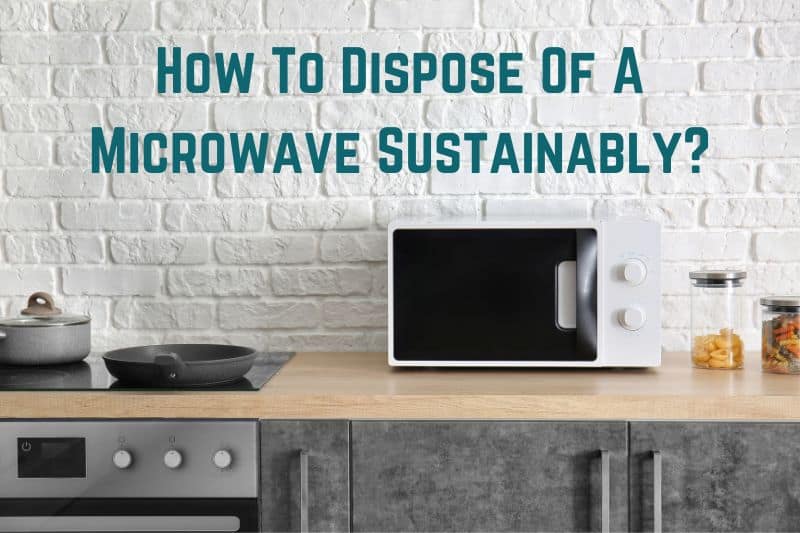Do you have any questions regarding what can be done with an old microwave? When broken, making a place for a fresh purchase may be necessary, or you might be decluttering. Whatever the case, you are at the correct place, so do not worry!
Microwave ovens are sometimes called e-waste because of their electrical components, and wrongfully disposed of can result in costly fines and legal issues. The safe and simple disposal of a microwave, as well as other key guidelines you must adhere to, are all covered in this article. We will even review a few sustainable disposal options for your old microwave.
Read: How Many Amps Does an Electric Oven Use? (Explained)
Ways To Dispose of Microwave Safely
Now that you have decided to replace your old microwave, you are looking for the best disposal method. Alternatively, you attempted to fix your broken microwave but were unsuccessful.
In either case, leaving it lying on the sidewalk for trash day may not be a good idea. There are other techniques to get rid of a microwave correctly.
1. Visit an Electronics Recycling Facility
The strict environmental requirements necessary to manage used electronics must be followed by certified electronic recyclers, also known as e-waste recyclers. Therefore, you can completely avoid the possibility that your old microwave will leak radiation or toxins by leaving it in the care of experts.
Disposal is now environmentally friendly for all parties. You must be able to identify your nearest facility with a short Internet search, as you will find electronic recycling facilities nationwide.
2. Donate It
You do not necessarily need to throw away your old microwave if it is not broken. Your used, functional microwaves can be donated to a variety of thrift shops and charities. These businesses frequently offer a specific drop-off service that makes donating your used electronics and microwave incredibly simple.
By giving, you assist a person in need and reduce hazardous e-waste emissions. A kind donation would help a neighborhood company.
3. Manufacturer Take-Back Programs
You can return your damaged or outdated microwave for its parts thanks to a take-back service provided by several reputable manufacturers. This assures the correct disposal, much like an electronic waste recycler, and you can be certain that no dangerous pollutants have been discharged into the atmosphere on your behalf.
Retailers occasionally provide a “trade-in” incentive if the microwave has broken and you need a new one. Asking will not hurt, even though some manufacturers do not permit this.
4. Sell It
Why not attempt to recoup part of the cash you initially invested in your microwave if it still functions or does not? Other people may be interested in buying microwaves’ important parts, such as the magnetron, glass trays, and transformer, for repairs on their own.
Take pictures of the microwave and list it with a thorough description on websites like Offer Up, Facebook Marketplace, eBay, and Craigslist. Of course, while doing so, you will need to be open and honest regarding the state of the microwave.
Can You Throw a Microwave in the Trash?
If you were about to dispose of your old microwave, reconsider. Since microwaves are produced from many different electrical parts, improper disposal could result in major issues. In many nations and towns, it is illegal to do this due to the potential for radiation leaks.
The simplest approach to get rid of your old microwave is to send it to the neighborhood landfill. However, it is detrimental to our garbage collectors’ health and the environment. It is simply not worth it.
Learn about the laws controlling e-waste and hazardous garbage in your area to avoid any fines or penalties for violating the law. For rules, a directory of authorized recyclers of gadgets, and RAD collaborators in your area, check out relevant websites like the EPA.

You can lawfully throw the microwave in the trash if, in the unlikely case, the municipality where you live does not have a policy on the disposal of e-waste. However, even in that scenario, you must first call your neighborhood municipality to find out if they can take it. The homeowner must typically pay a nominal charge to the city for this service.
Authorities occasionally demand a minimum weight or size for e-waste from particular locations or neighborhoods to qualify for collection service. If this applies to you, you can only get rid of it on bulk garbage pick-up days around once a year. This is the most responsible, secure, and practical way to dispose of a microwave without incurring any fees, even though there are better solutions than this one.
Are Microwaves Bad For the Environment?
Although they have certain environmental effects that vary in how they are produced, used, and gotten rid of, microwaves are not intrinsically detrimental to the environment. Microwaves’ energy usage, carbon emissions, and garbage production are the main environmental problems they cause.
Electromagnetic waves are produced by electricity-powered microwaves that heat water and food molecules. A microwave’s power evaluation, efficiency, frequency of use, and length affect how much electricity it needs.
An investigation by The University of Manchester found that over eight years, the typical microwave in the European Union consumes 573 kilowatt-hours of electricity. This is the same amount of electricity used by a 7-watt fluorescent bulb that has been on nonstop for nearly nine years.
A microwave can utilize electricity from various sources, including coal, hydro, natural gas, wind, solar, or nuclear. The ecological impact of the power, which measures the quantity of carbon dioxide (CO2) released per unit of electricity, might vary based on the source. A greenhouse gas called CO2 has a role in climate change and global warming.
Is It Safe To Fix a Broken Microwave?
For several reasons, disassembling a broken microwave to fix it is not secure. The microwave is an extremely high-voltage device; thus, you should never attempt to disassemble it while it is plugged in.
A large high-voltage capacitor and a high-voltage transformer can generate as much as 4,200 volts through its secondary coil. Even after you have unplugged the oven for months, this powerful device can still shock you with a lethal discharge.
The last component is the magnetron, which creates microwaves to warm your food. It is a unique variety of vacuum tubes equipped with strong magnets. Nothing is hazardous about those, but you must remove a sizable ceramic insulator to access them.
Beryllium oxide, a unique ceramic that is hazardous when inhaled, makes this insulator. The microwave might have changed how we prepare meals, but it is among the hardest and riskiest home equipment to fix.
The first thing to note is that microwaves are small, tightly packed machines. Due to this, you may need to disassemble a microwave in order to fix it. A high-voltage capacitor should be your top priority. Even months after use, it still has a strong electrical charge. The microwave capacitor should be safely discharged, whatever you do.
Alternatively, you could pay a specialist to repair your microwave. This makes sense, particularly if the harm caused is cosmetic rather than electrical. A damaged plate rotating assembly or a broken door hinge should be simple to fix and not cost much.
However, what happens if the control panel or magnetron in the oven needs to be replaced? Sending it to a microwave recycling facility might be a better option than paying to have it fixed. For instance, the cost of spare components for many less expensive microwave manufacturers is frequently higher than the price of a brand-new appliance.
FAQ’s
Do Any Microwave Parts Have Any Value?
The magnetron, transformer, cooling fans, capacitors, thermal fuses, turntables, power connectors, and vent fans are a few of the microwave’s key components. However, the glass door is the most valuable component.
Does Radiation Leak From Old Microwaves?
Microwave ovens will likely emit electromagnetic radiation if they are utilized while damaged or changed. Since you cannot smell or see microwaves, it is difficult to detect microwave radiation leaks.
How Long is the Lifespan of a Microwave?
The majority of microwaves are made to last up to ten years. However, even if yours is older than ten and seems in good shape, it might be time to change because technology advances and many devices have become more energy-efficient.
What Will Happen To Microwaves at Recycling Centers?
Microwaves are disassembled at a recycling facility both mechanically and manually. The pieces are cleaned and separated into various materials, such as plastics and metals. Collectible materials are delivered to specialists for additional processing; for instance, plastics are transported to processing facilities, while metals are sent to smelters.
Conclusion
The safest, greenest, and most effective way to get rid of an outdated or damaged microwave is through recycling. Of course, it would be simpler to dump your damaged microwave in the ordinary trash and go on. However, by doing so, you endanger both your own life and the lives of others.
Take the necessary steps and effort to get rid of your microwave correctly to prevent guilt or legal issues. You can dispose of an old microwave while contributing to the fight against harmful e-waste with a little extra work.






